Grass weeds have become more prevalent on Irish tillage farms. This is partly due to the loss of herbicide actives and options as a result of sensitivity loss or tighter regulation.
Monitoring this resistance in grass weeds is critical to detect the scale of a problem and this is important in terms of designing and developing integrated weed management (IWM) measures.
For a few years now, we have been monitoring resistance in grass weeds to ACCase or ALS herbicides.
Knowing where critical weeds (blackgrass, Italian ryegrass, bromes, wild oats, canary grass, etc) occur and the resistance status of the population is important to help mitigate against further spread and resistance development.
The mode of action is how a herbicide active interrupts the biological pathways of susceptible plants.
The ACCase herbicides control grass weeds by disrupting fatty acid synthesis, causing main shoot death at the growing point. These include three chemistries – Axial, Falcon and Stratos Ultra.
The ALS herbicides disrupt the synthesis of important amino acids, causing stunted growth or abnormal growth at the growing point. These include five chemistries, of which Pacifica and Broadway Star are used for grass weed control.
Nowadays, the use of ACCase/ALS herbicide chemistries are restricted by crop and weed specificity.
Remember, herbicides with the same mode of action control susceptible plants in a similar way. Therefore, resistance risks are the same whether you continuously use Axial, Falcon or Stratos from ACCase or Pacifica or Broadway Star from ALS, as the sole control option without IWM.
The survey
In 2020, 103 tillage farms from the south and east of the country were surveyed. Growers were interviewed to determine their resistance awareness, grass-weed problems and control tactics.
On each farm, one or more cereal field with grass weeds and known management history was selected for grid-based population assessments carried out before harvest in both 2020 and 2021.
For each approximate 24m x 24m grid square, a central GPS co-ordinate was logged and a weed score of 0 (absent) to 10 (complete weed cover) was recorded and validated by limited weed counts. Over 160 population seed samples were also collected for resistance testing in the glasshouse.
What we found
The majority of growers (85%) were aware of herbicide-resistant grass weeds in the country. But only 38% were aware of the presence of resistant grass weeds in their region or county. Nevertheless, over 90% of growers felt that grass-weed resistance could pose a significant economic challenge.
The most widespread species on the 103 farms surveyed were bromes, specifically sterile brome, and spring wild oats, found on 62% and 56% of farms, respectively.
About 10% of farms surveyed had invasive species – Italian ryegrass, lesser canary grass or blackgrass.
The overall weed score for these critical grass weeds varied between 1.6 (+/- 2.59) and 2.4 (+/- 3.23) (mean ± standard deviation), respectively, for the assessment years 2020 and 2021.
Figure 1 shows the intensity of weed score from 0 (absent) to 10 (complete weed cover) using different colours for farms surveyed for problem species.
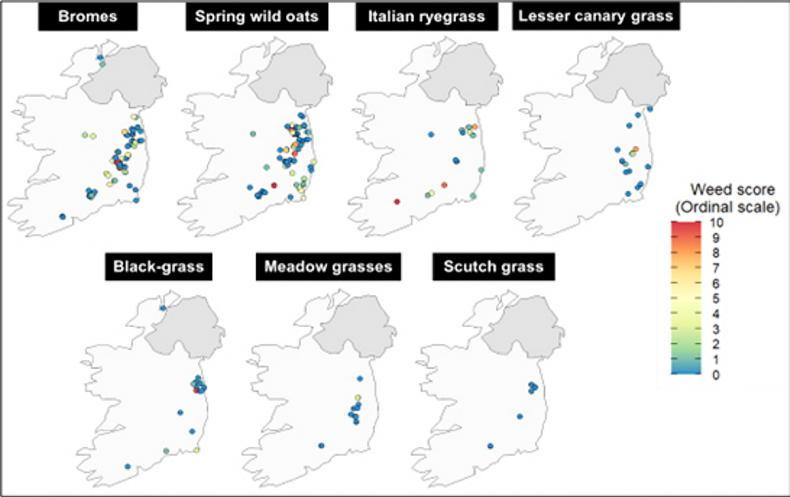
Figure 1: Field-level grass weed pressure on 103 tillage farms surveyed in 2020 and 2021. The colours relate to the mean weed score measured on a scale from 0 (absent) to 10 (complete weed cover). Data was recorded from 64 farms for bromes, 58 farms for spring wild oats; 13 farms for Italian ryegrass; 14 farms for canary grass and 16 farms for blackgrass. Note: Each farm would have more than one difficult-to-control species or surveyed fields or cereal crop type.
Within these, 16% of farms with bromes, 12% of farms with spring wild oats, 31% of farms with Italian ryegrass, 21% of farms with lesser canary grass and 6% of farms with blackgrass, had higher weed scores (4 to 10).
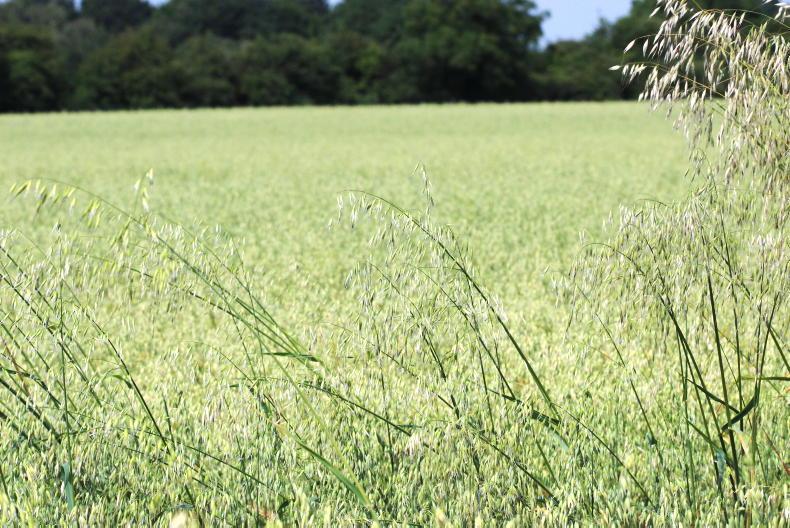
Wild oats are now present in the majority of tillage fields in the country.
While meadow grasses (annual or rough-stalk) are abundant in tillage fields, field margins and headlands, only nine farms had meadow grasses, all with lower weed scores (0 to 3), suggesting that effective control is possible with a range of generic herbicides such as pendimethalin, flufenacet, prosulfocarb, etc.
Likewise, only five surveyed farms had scutch, indicating that the use of glyphosate had helped to keep this weed under control.
Herbicide sensitivity screening identified 22 resistant grass weeds: five ALS-tolerant bromes, six ACCase-resistant spring wild oats, five ACCase and/or ALS-resistant Italian ryegrass, and six ACCase/ALS-resistant blackgrass.
The resistant grass weeds were found on 18 of the 103 farms surveyed and three of those farms had two or more resistant species (Figure 2).
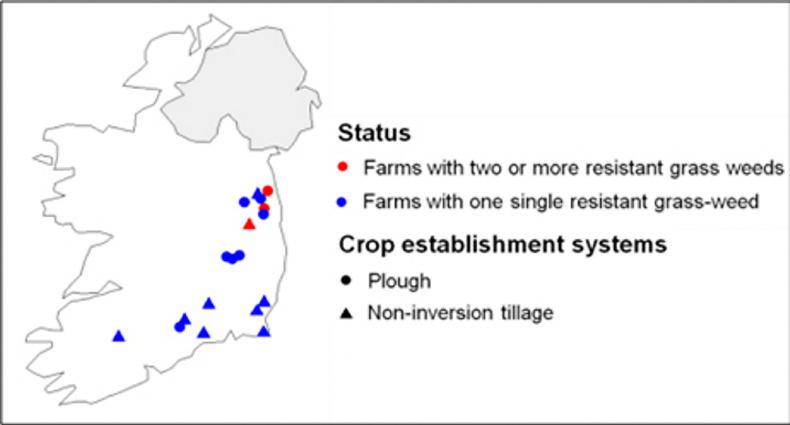
Figure 2: Maps the 18 farms (plough or non-inversion tillage) identified with herbicide-resistant grass weeds - three farms contained two or more resistant species.
Of the 18 farms that had resistance, nine were plough-based and nine were non-inversion tillage (Figure 2). This shows that plough-based systems are equally vulnerable to developing grass-weed resistance. Resistance has been documented in all tillage regions.
The most commonly used grass-weed control tactics by growers were:
Optimum timing of spring herbicide applications. Using glyphosate prior to sowing. Very early application of residual herbicides. Rotating autumn and spring crops. Ploughing. These results indicate that herbicides dominate current tactics.
Assessing the extent to which specific actions were practised, the grower responses for “always” or “very frequent” included:
Using certified seed (more than 70%).Practising machine hygiene before coming into fields (more than 50%).Hand rogueing for small infestations (less than 45%).Harvesting fields with high weed pressure last to avoid weed contamination (less than 30%).Practising machine hygiene before moving from field to field (less than 30%).Managing field margin/headlands using arable grass margin (less than 25%).These results suggest that growers are more likely to adopt specific actions as compensatory measures for reduced herbicide efficacy, which could be when resistance is already in the field.

It is increasingly common to have more than one grass weed species present in fields.
Key factors
Overall, increased winter cropping, reliance on ACCase/ALS herbicides, and the use of rates lower than the recommended field rate were key factors which contributed to resistance across systems.
The grower survey is important in terms of improving grass-weed research and advice.Control systems that depend on the repeated use of products with similar modes of herbicide action are vulnerable to grass-weed resistance development.Resistance cases are likely to increase in the future due to current farm practices. Eighteen farms (plough or non-inversion tillage) were identified as having herbicide-resistant grass weeds and three farms had two or more resistant species.
Grass weeds have become more prevalent on Irish tillage farms. This is partly due to the loss of herbicide actives and options as a result of sensitivity loss or tighter regulation.
Monitoring this resistance in grass weeds is critical to detect the scale of a problem and this is important in terms of designing and developing integrated weed management (IWM) measures.
For a few years now, we have been monitoring resistance in grass weeds to ACCase or ALS herbicides.
Knowing where critical weeds (blackgrass, Italian ryegrass, bromes, wild oats, canary grass, etc) occur and the resistance status of the population is important to help mitigate against further spread and resistance development.
The mode of action is how a herbicide active interrupts the biological pathways of susceptible plants.
The ACCase herbicides control grass weeds by disrupting fatty acid synthesis, causing main shoot death at the growing point. These include three chemistries – Axial, Falcon and Stratos Ultra.
The ALS herbicides disrupt the synthesis of important amino acids, causing stunted growth or abnormal growth at the growing point. These include five chemistries, of which Pacifica and Broadway Star are used for grass weed control.
Nowadays, the use of ACCase/ALS herbicide chemistries are restricted by crop and weed specificity.
Remember, herbicides with the same mode of action control susceptible plants in a similar way. Therefore, resistance risks are the same whether you continuously use Axial, Falcon or Stratos from ACCase or Pacifica or Broadway Star from ALS, as the sole control option without IWM.
The survey
In 2020, 103 tillage farms from the south and east of the country were surveyed. Growers were interviewed to determine their resistance awareness, grass-weed problems and control tactics.
On each farm, one or more cereal field with grass weeds and known management history was selected for grid-based population assessments carried out before harvest in both 2020 and 2021.
For each approximate 24m x 24m grid square, a central GPS co-ordinate was logged and a weed score of 0 (absent) to 10 (complete weed cover) was recorded and validated by limited weed counts. Over 160 population seed samples were also collected for resistance testing in the glasshouse.
What we found
The majority of growers (85%) were aware of herbicide-resistant grass weeds in the country. But only 38% were aware of the presence of resistant grass weeds in their region or county. Nevertheless, over 90% of growers felt that grass-weed resistance could pose a significant economic challenge.
The most widespread species on the 103 farms surveyed were bromes, specifically sterile brome, and spring wild oats, found on 62% and 56% of farms, respectively.
About 10% of farms surveyed had invasive species – Italian ryegrass, lesser canary grass or blackgrass.
The overall weed score for these critical grass weeds varied between 1.6 (+/- 2.59) and 2.4 (+/- 3.23) (mean ± standard deviation), respectively, for the assessment years 2020 and 2021.
Figure 1 shows the intensity of weed score from 0 (absent) to 10 (complete weed cover) using different colours for farms surveyed for problem species.

Figure 1: Field-level grass weed pressure on 103 tillage farms surveyed in 2020 and 2021. The colours relate to the mean weed score measured on a scale from 0 (absent) to 10 (complete weed cover). Data was recorded from 64 farms for bromes, 58 farms for spring wild oats; 13 farms for Italian ryegrass; 14 farms for canary grass and 16 farms for blackgrass. Note: Each farm would have more than one difficult-to-control species or surveyed fields or cereal crop type.
Within these, 16% of farms with bromes, 12% of farms with spring wild oats, 31% of farms with Italian ryegrass, 21% of farms with lesser canary grass and 6% of farms with blackgrass, had higher weed scores (4 to 10).

Wild oats are now present in the majority of tillage fields in the country.
While meadow grasses (annual or rough-stalk) are abundant in tillage fields, field margins and headlands, only nine farms had meadow grasses, all with lower weed scores (0 to 3), suggesting that effective control is possible with a range of generic herbicides such as pendimethalin, flufenacet, prosulfocarb, etc.
Likewise, only five surveyed farms had scutch, indicating that the use of glyphosate had helped to keep this weed under control.
Herbicide sensitivity screening identified 22 resistant grass weeds: five ALS-tolerant bromes, six ACCase-resistant spring wild oats, five ACCase and/or ALS-resistant Italian ryegrass, and six ACCase/ALS-resistant blackgrass.
The resistant grass weeds were found on 18 of the 103 farms surveyed and three of those farms had two or more resistant species (Figure 2).

Figure 2: Maps the 18 farms (plough or non-inversion tillage) identified with herbicide-resistant grass weeds - three farms contained two or more resistant species.
Of the 18 farms that had resistance, nine were plough-based and nine were non-inversion tillage (Figure 2). This shows that plough-based systems are equally vulnerable to developing grass-weed resistance. Resistance has been documented in all tillage regions.
The most commonly used grass-weed control tactics by growers were:
Optimum timing of spring herbicide applications. Using glyphosate prior to sowing. Very early application of residual herbicides. Rotating autumn and spring crops. Ploughing. These results indicate that herbicides dominate current tactics.
Assessing the extent to which specific actions were practised, the grower responses for “always” or “very frequent” included:
Using certified seed (more than 70%).Practising machine hygiene before coming into fields (more than 50%).Hand rogueing for small infestations (less than 45%).Harvesting fields with high weed pressure last to avoid weed contamination (less than 30%).Practising machine hygiene before moving from field to field (less than 30%).Managing field margin/headlands using arable grass margin (less than 25%).These results suggest that growers are more likely to adopt specific actions as compensatory measures for reduced herbicide efficacy, which could be when resistance is already in the field.

It is increasingly common to have more than one grass weed species present in fields.
Key factors
Overall, increased winter cropping, reliance on ACCase/ALS herbicides, and the use of rates lower than the recommended field rate were key factors which contributed to resistance across systems.
The grower survey is important in terms of improving grass-weed research and advice.Control systems that depend on the repeated use of products with similar modes of herbicide action are vulnerable to grass-weed resistance development.Resistance cases are likely to increase in the future due to current farm practices. Eighteen farms (plough or non-inversion tillage) were identified as having herbicide-resistant grass weeds and three farms had two or more resistant species. 








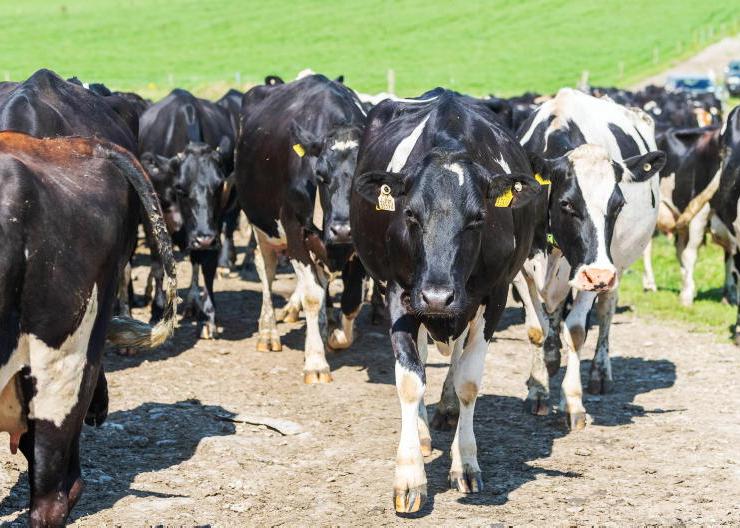

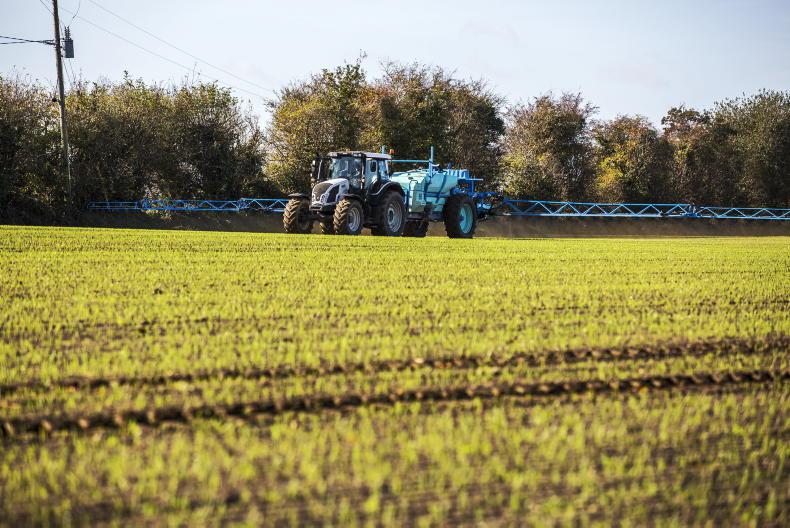

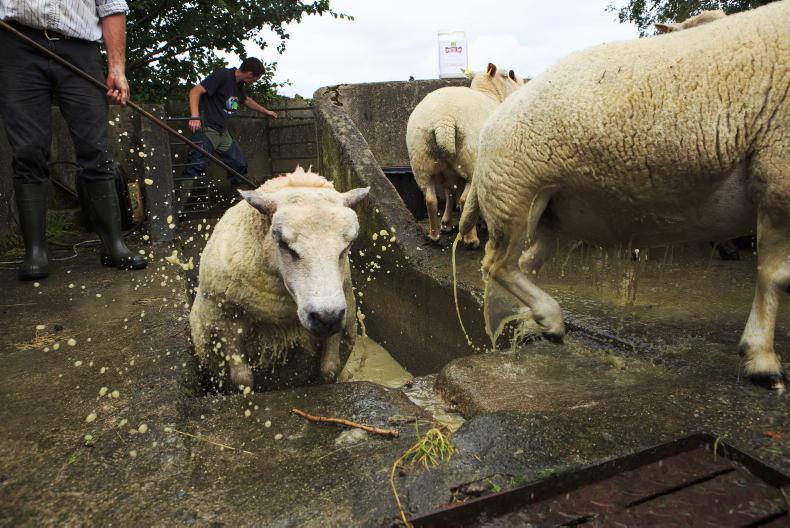
SHARING OPTIONS